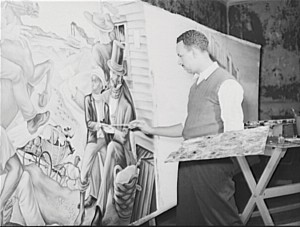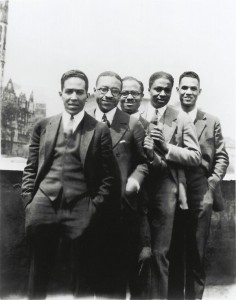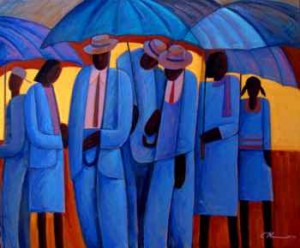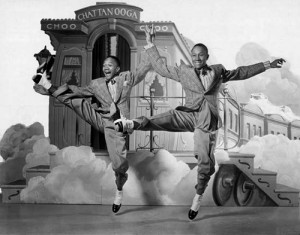Introduction
The Harlem Renaissance was a period in American and African American history that lasted from approximately 1918 until 1938. Due to staunch Jim Crow laws in the South, and a majority of the population feeling the effects of post-war, economic depression, many African Americans found themselves migrating towards the industrialized, Northern cities. After centuries of slavery, segregation laws, and staunch prejudice, many African Americans saw a new-found hope in the Northern region of the country. However, when they began to make their way into these Northern cities, they discovered that prejudice still resided in the greater populace. Segregationist views forced many migrants to forge close bonds with one another. As a direct effect of this, “black neighborhoods” and “white neighborhoods” began to emerge throughout the cities. With scarce economic opportunity, artistic expression became an outlet for many black intellectuals, writers, artists, and photographers. Although this literary and artistic explosion was not confined to one particular neighborhood, many found themselves sharing their talents in Harlem, New York.
Through embracing their various artistic talents, many African Americans found themselves seeking self-expression through their works. Many players in the New Negro Movement, saw this volatile time as an opportunity to debunk the prejudice stereotypes they had been combating for centuries. This became a catalyst for a national social movement, and a re-conceptualization about how many blacks saw themselves. Alain LeRoy Locke, a sociologist and writer, coined this time in history as “The New Negro Movement.” Due to their previous stalwart cultural repression, many African American youths saw this time as celebratory; they gained a connection to their heritage and to one another for the first time. Many argue that it was the Harlem Renaissance and this re-conceptualized vision of the “New Negro” that acted as a catalyst for the African American Civil Rights Movement.
Primary and Print Sources
Locke, Alain. The New Negro: An Interpretation. New York: Arno Press, 1968.519cBWGToKL._SY344_BO1,204,203,200_
- Alain Locke’s 1925 book, The New Negro: An Interpretation, is a compilation of poetic works, fiction pieces, and dissertations about the African American community throughout the Harlem Renaissance. It is compiled of three distinct sections; “The Negro Renaissance”, “The New Negro in a New World”, and a bibliography of various African American works. Locke’s anthology aimed to demonstrate the ways in which African Americans were advancing intellectually, culturally, and socially. It sought to call upon the black community to take part in the New Negro Movement. It also sought to speak to white Americans to demonstrate that the black community was shedding old stereotypes. The New Negro focused on formulating a sense of unity in the African American community towards achieving the image of the “New Negro.” Locke’s work, although influential, is problematic because the collection of works that Locke compiles is highly disjointed. It lacks continuity, coherence, and disappoints to characterize and signify the importance of many other groundbreaking African American movements during that time.
Cassidy, Donna M. Painting the Musical City: Jazz and Cultural Identity in American Art, 1910-1940. Washington, DC: Smithsonian Institution Press, 1997.
- This provides information about the role that jazz music played in the Harlem Renaissance. Through imagery, Cassidy argues that it was jazz, more than anything, that conceptualized new racial pride in the African American community throughout the early 20th century.
 Schuyler, George S. Black No More. Modern Library ed. New York: Modern Library, 1999.
Schuyler, George S. Black No More. Modern Library ed. New York: Modern Library, 1999.
- Black No More, written by George S. Schuyler is a satirical, science fiction novel that unpacks racial issues that existed throughout the Harlem Renaissance. The storyline involves a scientist who succeeds at finding a cure for black skin, making him capable at changing the entire population into white Americans. Through formulating a fictional world in cohesion with a satirical, Schuyler attempts to make comparisons to the real world politics of social and racial structure in the country. It is important to note that this piece is controversial because it exploits a wide array of people drawn from all races and social hierarchies. In Black No More, Schuyler draws connections between the aesthetic expectation of African Americans to “whiten themselves” through skin and hair treatments and his fictional “cure.” In doing so, he frames an argument about the ways in which racism and prejudice effect society as a whole.
Toomer, Jean. Cane. New York: Liveright, 1975.
- A novel written in 1923, author Jean Toomer discusses the issues of segregation, prejudice, and lynching. Toomer’s piece is a compilation of various writing styles ranging from prose and poetry, to stories with religious innuendos. The primary goal of this piece is to demonstrate, through various literary forms, the strife that many African Americans were still subject to during the time of the New Negro Movement.
 Bloom, Harold.. Black American Poets and Dramatists of the Harlem Renaissance. New York: Chelsea House, 1996.
Bloom, Harold.. Black American Poets and Dramatists of the Harlem Renaissance. New York: Chelsea House, 1996.
- This offers a wide variety of data about various players in the Harlem Renaissance. It includes background information about these individuals, various works that each produced, and illustrations of each.
Hughes, Langston. Selected Poems. New York: Knopf, 1959.
- Selected Poems, provides a compilation of various works by the late Langston Hughes. His works acted as chronicle of many African American world-views, women’s issues, and racial matters throughout his time. Hughes was a popularized figure during and after the Harlem Renaissance because his works focused on the past, present, and future of the African American race. Furthermore, Selected Poems offers a wide variety of his works, varying from discussions of Jim Crow laws in the South, to black neighborhoods in the Northern cities.
- Although some sections of this compendium do not hold as much weight and meaning as others, it remains noteworthy because it acts as a collection of various works from one of the most influential figures of the Harlem Renaissance. Its main purpose is to demonstrate the issues that resided in the country pre and post-World War I both racially and socially.
The following is a picture of Langston Hughes amongst other key players in the Harlem Renaissance. He can be seen on the far left.
Hutchinson, George. The Harlem Renaissance in Black and White. Cambridge: The Belknap Press of Harvard University, 1995.
- George Hutchinson offers a comprehensive view of the Harlem Renaissance and its cultural history. He does so by dividing the piece into two sections; the first offers information as to the circumstances surrounding this intellectual movement, and the second analyzes the ways in which the publishing industry changed the course of the New Negro movement. He does so through analyzes many common African American magazines such as The Crisis, the Messenger, and others.

Larsen, Nella. Passing. New York: Penguin Books, 1997.
- A reproduction of a 1930s novel, Passing, is a piece about the interracial issues that resided throughout the nation (in particular, Harlem), during the 1920s. Through depicting a woman who is conflicted with sharing her true racial identity, Larsen examines Harlem’s black upper class during this era. Larsen’s novel, although fiction, depicts the staunch realism those of mixed descent faced in the 1920s: issues of social status, sexuality, racial lines, and personal struggle.
Spencer, Jon Michael. The New Negroes and Their Music: The Success of the Harlem Renaissance. Knoxville: University of Tennessee Press, 1997.
- Jon Michael Spencer offers a comprehensive perspective as to the role that music played on the New Negro Movement. He takes a revisionist approach to the Renaissance by circumventing the literary works of the time, and primarily focusing on music. Spencer argues that it was music during the Renaissance that created the ambiance and disposition for it. Furthermore, he claims that the Renaissance did not conclude with the start of the Great Depression, but rather lasted far longer.
Johnson, James Weldon, and Elizabeth Catlett. Lift Every Voice and Sing. New York: Walker, 1993.
- Lift Every Voice and Sing, often referred to as “The African American National Anthem”, was a poem, later set to music, by James Weldon Johnson. Its original purpose was to introduce famous guest speaker, Booker T. Washington at a speech in Florida. Over time, the National Association for the Advancement of Colored People, or the NAACP, adopted it as their official mantra. The piece discusses the dark history of African Americans in lines such as “treading our path through the blood of the slaughtered” and optimism for the future “may we forever stand/ true to our God, true to our native land.” The hymn, over time, eventually made its way into several churches and became a ballad to the African American Civil Rights Movement in decades following.
Fauset, Jessie R edmon. There Is Confusion. Boston: Northeastern University Press, 1989.
edmon. There Is Confusion. Boston: Northeastern University Press, 1989.
- There is Confusion, originally produced in 1924, was written by the editor of the famous Crisis Magazine, Jessie Redmon Fauset. The goal of Fauset’s novel was to give insight as to the everyday strife of African American youths during the post WWI era. Through focusing on the individual, private struggles of the main characters, Fauset aspires to reach a wide array of people, and place emphasis on unifying the grandeur community.
Johnson, James Weldon. The Autobiography of an Ex-colored Man. Auckland, N.Z.: Floating Press, 2009.
- The Autobiography of an Ex-colored Man, a book written by the James Weldon Johnson (the same author as Lift Every Voice and Sing), discusses the common issue of the 1920s of “passing” racial lines. It illuminates themes of race such as hiding one’s black heritage, the treachery of “passing”, and other struggles that African Americans faced in a segregated and prejudice world. Moreover, the novel is teeming with pictures of American life in early twentieth century, ranging from pictures of the Southern experience, to that of Harlem and various neighborhoods in New York City.
Wilson, James F. Bulldaggers, Pansies, and Chocolate Babies: Performance, Race, and Sexuality in the Harlem Renaissance. Michigan: University of Michigan Press, 2010
Bulldaggers, Pansies, and Chocolate Babies offers a historical analysis of the cultural framework of the race, sexuality, and social status during the 1920s. Wilson uses a combination of personal analysis with information derived from various pieces of the 1920s: magazines/newspapers, eyewitness accounts, play scripts, court documents, novels of the time, and biographical pieces. He argues in opposition to a common-held notion that black and homosexual aspects of theater in the 1920s inhibited the development of their new-found self-declaration. Through drawing upon works of famous African American participants of the Harlem Renaissance (Hughes, Hurston, DuBois, Bently, Waters, etc) Wilson argues that the gay and lesbian community during the 1920s and early 1930s, contributed just as much to the future of Civil Rights, as did the black community. Note: This piece is based upon personal opinion derived from primary sources and personal reflection.
Digital Resources
Library of Congress Guide to the Harlem Renaissance.
This digital guide, produced by the Library of Congress, offers a wide array of music, art, photographs, and writing from participants in the Harlem Renaissance. Additionally, the Library of Congress offers a selected bibliography, links to various exhibitions of artists and photographers, as well as other useful sources relating to the early 20th century and black history.
Press, Associated. “First Lady Celebrates Harlem Renaissance.” Los Angeles Times. March 14, 2002. Accessed November 21, 2014.
- This article demonstrates the legacy of the Harlem Renaissance. It discusses an event that took place in the year 2002, in which First Lady Laura Bush led a discussion about the role that the Harlem Renaissance had in changing African American history in America.
- Although it accredits the Harlem Renaissance for changing civil rights in America and acting as a catalyst for future African American culture, this article has historical inaccuracies; neglects to examine the harsh brutality that many blacks faced during this time. For instance, the article claims that blacks escaping Jim Crow in the South could find “well-paying jobs, have fun and write what they wanted.” During this time, racism still existed in the North, and the black community was segregated to sectioned-off neighborhoods. Additionally, because it was extremely difficult for the African community to find well-paying jobs, literature and the arts acted as their true “welcome haven.” Finally, the pieces that came out of the Harlem Renaissance were not works of “fun”, but rather attempts at civility.
Oklahoma City Museum of Art Guide to the Harlem Renaissance
- Produced by the Oklahoma City Museum of Art, this online resource is a vast, digitized archive of art and photography taken during the Harlem Renaissance. It also offers generalized information about each piece, and the New Negro Movement as a whole.
The Harlem Renaissance Contributon Site.
- This is an online resource in which various contributors can reply to books or pieces written about or during the Harlem Renaissance, and then respond to one another. This source allows discourse amongst various people and groups about the topic at hand. This “blog-type” reference covers a wide array of topics relating to the Harlem Renaissance during World War I, to the legacy it left behind for the civil rights movement in the 60s. Although this piece is accommodating in extending across a wide array of public opinion and source material, it is imperative to be weary that many of the pieces are either editorials or commentaries upon others exposes. It is a secondary source of information. That being said, this blog may present juxtaposing outlooks on the same focus/subject matter.
Archives of the Crisis Magazine.
- This website, sponsored by the University of Pennsylvania, holds record of various articles from the famous African American, NAACP supported, magazine, Crisis. The site offers a brief description of the magazine and its publication history, followed by external links to where each issue can be found with its respective dates of publication.
The Harlem Renaissance Video Clip.
- This electronic source offers a short description of the Harlem Renaissance with a short chronicle of the 1920s for the African American community. It starts off with a brief description of the typical view that many had of the 1920s “flappers and speakeasies” and examines how this time was volatile and transformative for African American migrants who sought “equality and equal rights.” It offers a helpful, although brief description of the various aspects that formulated the New Negro Movement (post-World War I migration, various writers and artists during that time, the Great Depression, the legacy it left for “future American politics”.)
The Harlem Renaissance- Black Cultural Movement in Art and Literature.
- This short clip, although it contains no spoken audio, offers visual insight into the Black Art Movement that was taking place during the 1920s and 1930s. It presents collage of various photographs of intellectuals, musicians, pieces of art, etc. and exhibits the creative movement that was transpiring during that time period.
The Cotton Club in the Harlem Renaissance.
- This brief video offers an anthology of various photographs of the cotton club and the Harlem Renaissance. It presents facts about the music scene during that time, issues of prohibition, and staunch prejudice that surrounded the Cotton club policies. The primary purpose of this video is to discuss the importance that the Cotton Club, played in the lives of many key players of the Harlem Renaissance, and the New Negro movement in its entirety.
Below are various videos of from the Harlem Renaissance:
http://https://www.youtube.com/watch?v=WzLQKLGrC78
Working Bibliography:
- Locke, Alain. The New Negro: An Interpretation. New York: Arno Press, 1968.
- Schuyler, George S. Black No More. Modern Library ed. New York: Modern Library, 1999.
- Hughes, Langston.Selected Poems. New York: Knopf, 1959.
- “The Harlem Renaissance – Black Cultural Movement in Art Music and Literature.” YouTube. January 2, 2012. Accessed November 19, 2014. The Harlem Renaissance- Black Cultural Movement in Art and Literature.
- “The Cotton Club – Harlem Renaissance.” YouTube. April 27, 2011. Accessed November 14, 2014. The Cotton Club in the Harlem Renaissance.
- “Harlem Renaissance.” History.com. January 1, 2009. Accessed November 19, 2014. The Harlem Renaissance Video Clip.
- “Site | H-Net: The Harlem Renaissance Discussion Board.” Site | H-Net. Accessed December 1, 2014. The Harlem Renaissance Contributon Site.
- Press, Associated. “First Lady Celebrates Harlem Renaissance.” Los Angeles Times. March 14, 2002. Accessed November 21, 2014.
- Wilson, James F. Bulldaggers, Pansies, and Chocolate Babies: Performance, Race, and Sexuality in the Harlem Renaissance. Michigan: University of Michigan Press, 2010
- Toomer, Jean. Cane. New York: Liveright, 1975.
- “The Crisis.” Crisis Magazine Digitalized Archives. Accessed November 4, 2014. Digitalized Archives of the Crisis Magazine.
- McMillian, Angela. “A Guide to Harlem Renaissance Materials.” Harlem Renaissance Resources (Virtual Programs & Services, Library of Congress). Accessed October 29, 2014. Library of Congress Guide to the Harlem Renaissance.
- Johnson, James Weldon. The Autobiography of an Ex-colored Man. Auckland, N.Z.: Floating Press, 2009.
- Bloom, Harold.. Black American Poets and Dramatists of the Harlem Renaissance. New York: Chelsea House, 1996.
- Fauset, Jessie Redmon. There Is Confusion. Boston: Northeastern University Press, 1989.
- Johnson, James Weldon, and Elizabeth Catlett. Lift Every Voice and Sing. New York: Walker, 1993.
- “Harlem Renaissance.” Oklahoma City Museum of Art Guide to the Harlem Renaissance. March 4, 2009. Accessed October 12, 2014. Oklahoma City Museum of Art Guide to the Harlem Renaissance
- Larsen, Nella. Passing. New York: Penguin Books, 1997.
- Bloom, Harold.. Black American Poets and Dramatists of the Harlem Renaissance. New York: Chelsea House, 1996.
- Hutchinson, George. The Harlem Renaissance in Black and White. Cambridge: The Belknap Press of Harvard University, 1995.
- Spencer, Jon Michael. The New Negroes and Their Music: The Success of the Harlem Renaissance. Knoxville: University of Tennessee Press, 1997.









